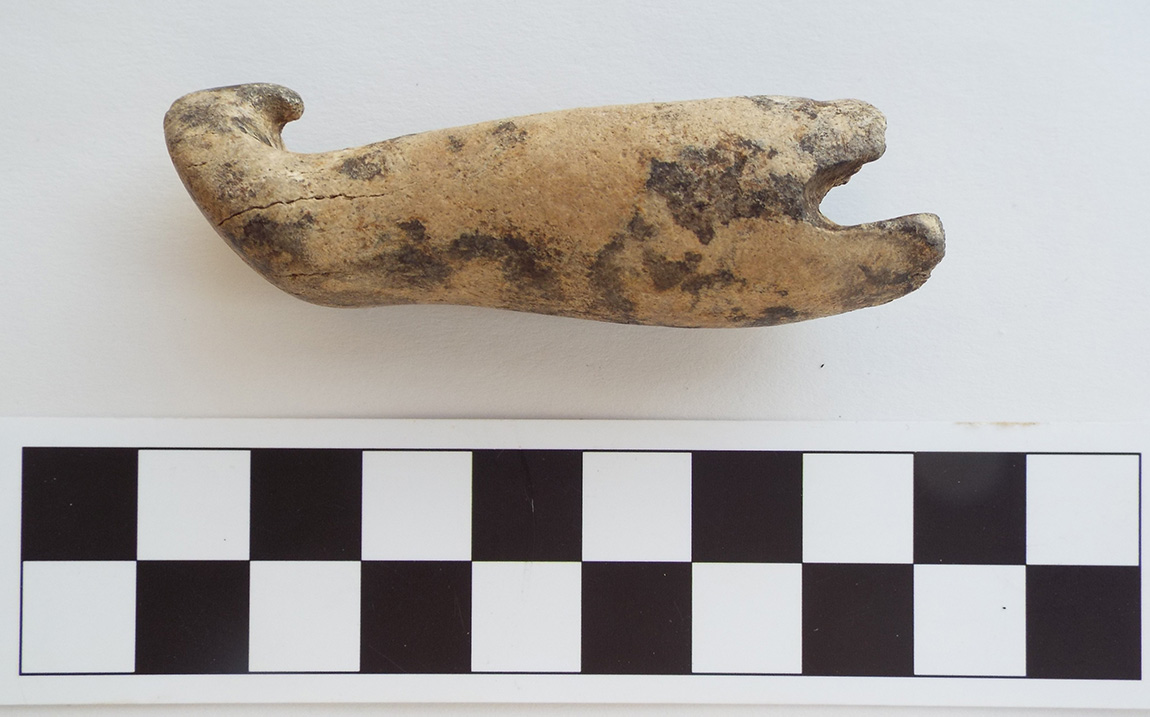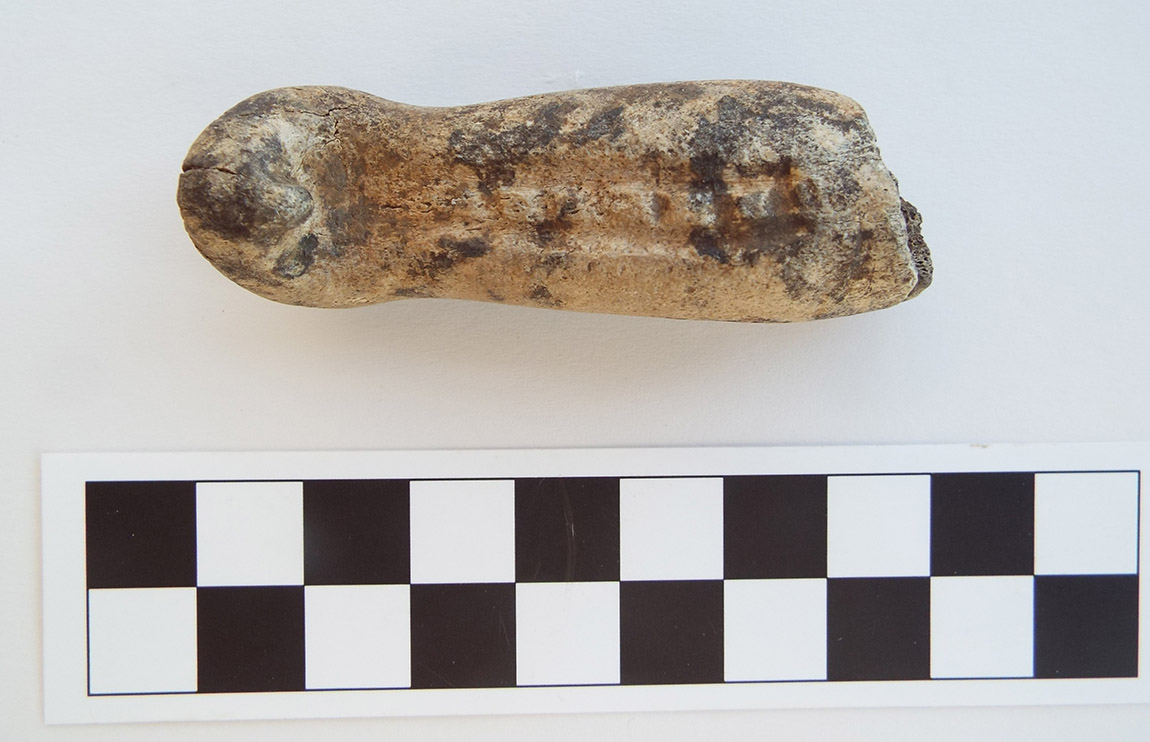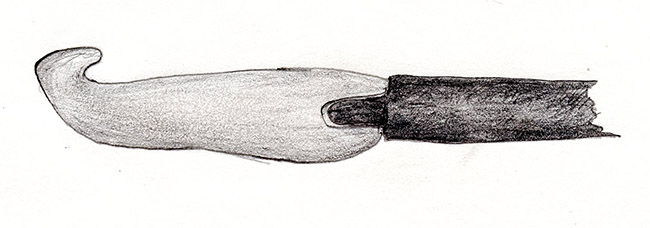
Larry Porter, ARAS-WRI Research Station
Artifact of the Month - January 2020
January’s artifact of the month is an atlatl hook from the Wild Violet site, 3LO226. Atlatls, or throwing sticks, extend the reach of the human arm when hunting with a spear. The hook is the part of the atlatl against which the spear haft rests as the hunter prepares to throw.
This artifact was found exposed by flood water on the surface of a large, deep (ca. 3m) trash deposit in 2016 by Arkansas Archeological Society member and site steward Mark Hise on a routine site visit following a particularly severe flood. Atlatl hooks are relatively rare in the archeological record, particularly on open sites, because they are typically made from perishable materials such as shell, bone, and antler. The Wild Violet site has unusually good bone preservation.
This atlatl hook is made from a short section of antler. It measures 52.22mm in overall length, and at its thickest point is 18.12mm wide. At the top edge of one end a shallow notch has been carved forming a short pointed projection, or hook, measuring 11mm in length. The opposite end has a horizontal notch which forms two prong-like projections [Figure 1]. This notch is 5.52mm wide. Its length cannot be accurately determined due to some damage or deterioration at that end but the longer of the two prongs is 10mm.
The top edge of this object [Figure 2] has been flattened and there are two carved lengthwise parallel grooves. The resulting raised ridge between the grooves is divided by perpendicular notches into six, possibly seven, rectangular humps. The purpose of the groove and raised notched ridge along the top edge is uncertain. One suggestion is that it could have stabilized the dart prior to throwing. Or it could simply be decorative. There is an atlatl hook from an excavated context at the Wann site in eastern Oklahoma that has an identical groove and notched ridge arrangement [Sharrock 1960 Plate V]. Further afield, Harrington [1960 Plate XXV] illustrates a preserved atlatl dart foreshaft that exhibits a remarkably similar notched ridge arrangement running lengthwise along the foreshaft in at least two places.

Atlatl hooks are designed to fit on the end of an atlatl handle and hook into a socket in the end of a lightweight dart or spear. A suggested hafting method for this example would involve fitting the two projecting prongs over a shaped tab of wood at the end of the atlatl handle, then securely attaching it with lashing, adhesive, or both [Figure 3].
An atlatl in its most basic form can consist simply of a wooden stick with a hook carved into one end of it. One well preserved example of this type of atlatl was found by Harrington [1960, Plate XV] in the Allred Shelter in the Arkansas Ozarks. It would serve its purpose perfectly well without a fancy carved hook. It’s uncertain if adding a separate hook enhances an atlatl’s effectiveness. It seems likely to be as much esthetic or an expression of artistic identity as strictly functional.

Atlatls have been in use in North America since the earliest prehistoric people occupied this continent and are still in use by some indigenous cultures, particularly in the Arctic. Some states in the U.S. permit hunting with atlatls by modern hunters. The atlatl is considered to be one of the earliest human mechanical inventions. By essentially adding length to one’s arm the atlatl permits the thrower to hurl a dart much farther and with much more force than is possible by hand throwing (https://worldatlatl.org, accessed November 2019.) Some of the better documented atlatl components found archeologically are from the Indian Knoll site, an Archaic shell midden in Kentucky where numerous examples were found in burial contexts (Webb 1974). In Arkansas Dr. Frank Schambach illustrates several atlatl hooks recovered in excavations at the Cooper site, 3HS1, which he estimates to be from a Late Archaic to Early Woodland component (Schambach 1998).
The long time span of use makes it difficult to assign age or specific cultural affiliation to a single isolated atlatl hook. But in the case of this particular example it is much easier to confidently place it in a cultural context. A considerable amount of archeological investigation has occurred at the Wild Violet site over the past nearly thirty years, including a major salvage excavation in 2013 (Porter 2016). Analysis of the data from that project indicates the primary occupation is Middle to Late Woodland period (roughly 200 BC - AD 900). The proliferation of large dart points, mostly of the Gary type, seems to support the extensive use of the atlatl by the Wild Violet inhabitants. Interestingly, the large number of arrow points from this site might indicate an overlap in the use of the atlatl and bow. A Woodland period cultural context is further supported by the presence of a near identical bone atlatl hook from a similarly aged site in eastern Oklahoma (Sharrock 1960).
In any case this is a very interesting and relatively rare artifact that gives us a look at both the artistic expression and practical use of an object by Woodland period people in this region.
References cited
Harrington, M. R.
1960 The Ozark Bluff Dwellers. Indian Notes and Monographs vol. XII. Museum of the American Indian, Heye Foundation. New York.
Porter, Larry
2016 Salvage Excavations at the Wild Violet Site, 3LO226, A Woodland Period Site in Logan County, Arkansas. ARAS Project No. 13-06 Final Report, December 2016. Ms. on file, Arkansas Archeological Survey, Fayetteville.
Schambach, Frank F.
1998 Pre-Caddoan Cultures in the Trans Mississippi South: A Beginning Sequence. Research Series No. 53. Arkansas Archeological Survey, Fayetteville.
Sharrock, Floyd W.
1960 The Wann Site, Lf-27, of the Fourche Maline Focus. Bulletin of the Oklahoma Anthropological Society Vol. VIII.
Webb, William S.
1974 Indian Knoll, Site OH2, Ohio County, Kentucky. University of Tennessee Press. Knoxville. Reprinted from 1946 edition published by University of Kentucky.
https://worldatlatl.org/ accessed November 2019
 Collections and items in our institution have incomplete, inaccurate, and/or missing attribution. We are using this notice to clearly identify this material so that it can be updated, or corrected by communities of origin. Our institution is committed to collaboration and partnerships to address this problem of incorrect or missing attribution. For more information, visit localcontexts.org.
Collections and items in our institution have incomplete, inaccurate, and/or missing attribution. We are using this notice to clearly identify this material so that it can be updated, or corrected by communities of origin. Our institution is committed to collaboration and partnerships to address this problem of incorrect or missing attribution. For more information, visit localcontexts.org.
 The Arkansas Archeological Survey is committed to the development of new modes of collaboration, engagement, and partnership with Indigenous peoples for the care and stewardship of past and future heritage collections.
The Arkansas Archeological Survey is committed to the development of new modes of collaboration, engagement, and partnership with Indigenous peoples for the care and stewardship of past and future heritage collections.
 The TK Notice is a visible notification that there are accompanying cultural rights and responsibilities that need further attention for any future sharing and use of this material. The TK Notice may indicate that TK Labels are in development and their implementation is being negotiated. For more information about the TK Notice, visit localcontexts.org.
The TK Notice is a visible notification that there are accompanying cultural rights and responsibilities that need further attention for any future sharing and use of this material. The TK Notice may indicate that TK Labels are in development and their implementation is being negotiated. For more information about the TK Notice, visit localcontexts.org.
